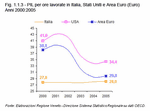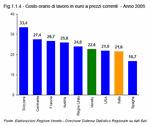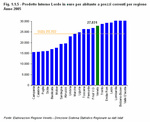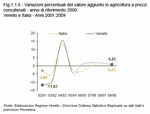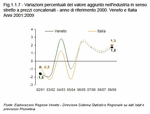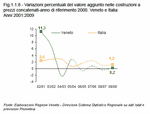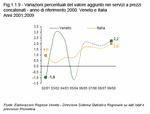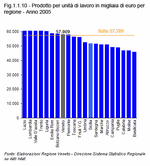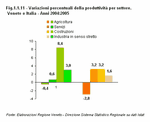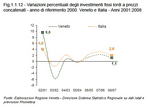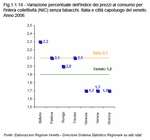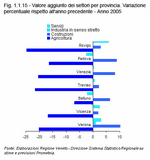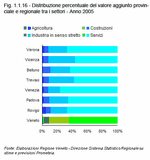|
1.1 - World growth and the Veneto economy
"In a challenging environment, organisations excel provided that they manage to find adequate resources and show greater determination in achieving bold objectives". These were the words of Michael Porter (Note 1), who summarised how nations, regions, or enterprises were to build a competitive advantage. In accordance with the EU's plans for the 2007-2013 cycle, which identifies "regional competitiveness and employment" as one of the main objectives, this chapter aims to analyse the international, national and local economic situations via the macroeconomic elements that can be used to boost the competitiveness of a territory.
In 2006, the world economy continued to grow quickly (+5.2%), maintaining the upward trend of the last ten years; one which is set to continue. International trade continues to expand and is driven by the growth of emerging economies. Indeed it is set to grow by +9% in 2006. 2004-06 is the 3-year-period with the highest and most dynamic trade growth since the oil boom of the 1970s. (Table 1.1.1) and (Figure 1.1.1).
Commodity cost (Note 2) has a major effect on a country's competitiveness. In emerging areas, especially in China and India, the high demand for raw materials keeps prices up, but at the same time the enormous labour supply within Asiatic countries contains the cost of commodities. Consequently, these countries are able to compensate for the increase in raw material prices as costs are not completely offloaded onto finished products. The consequence is that prices of manufactured goods have risen less than those of commodities, and the greater presence of low-cost manufactured goods on the market has neutralised the effect of higher oil prices on inflation.
Within the European Monetary Union, GDP in 2006 returned to positive territory, growing by 2.8%. This growth is supported by internal demand, exports and growing investments. The European Commission's Business Climate indicator remains high, but it predicts a marginal slowdown in GDP in 2007. All European countries registered a growth in 2006, including Germany and Italy, which had shown signs of weakness the previous year. The annual average growth of Germany in 2006 was 2.6%. This can be explained by the improved competitiveness of German products on foreign markets and by the recovery of investments in construction and production, which were driven by the low cost of credit and by good business profit. France's GDP, however, was less sprightly at +2.0%, which showed the two faces of this economy. On one side was the strength of household consumption and service production, on the other was the disappointing progress of industrial production, in particular within the automobile industry. Spain ended 2006 by recording a 3.9% increase in GDP, much higher than the EMU average, and a sustained rise in employment. In the United Kingdom, GDP grew by 2.7% in 2006, which demonstrates the strength of a development model driven mainly by the growth of services. (Table 1.1.4)
The expansion cycle currently underway also favours the recovery of labour productivity in Europe after a long downward trend that worsened during the 1990s. Among the causes are the slowdown both in capital intensity and in total productivity factors. This was the opposite to what has happened in the USA where great emphasis is placed on new information and communication in order to strengthen capital intensity and total productivity factors. Although the EMU reached its nadir in 2004, a recovery in labour productivity is currently underway and is particularly apparent in the industrial, commerce, transport and communications sectors. (Figure 1.1.3)
On the other hand, labour costs are worsening in the major European countries, a key factor in the competitiveness and attractiveness of a territory. Labour costs in Europe are still high, and indeed they are rising more quickly than in the United States; only Spain has competitive hourly labour costs. Investors in Europe are not only looking for low-cost labour, but also for high professionalism. Several studies (Note 3) have revealed that labour costs are one of the factors that, alongside work conditions, make it easier for an enterprise to localise. (Figure 1.1.4).
From 2000-2005, Italy's economy was characterised by a prolonged period of stagnancy that lasted much longer than previous cycles, hitting rock bottom in early 2005. The economy started to recover slowly in February 2005, but gained momentum, and in 2006 it recorded an increase in GDP of 1.9%, which was in line with growth in the second half of the 1990s. At the root of this recovery were factors linked both with an upsurge in Europe and with a period of reorganisation and/or adjustment underway in the sectors most exposed to international competition, and in the manufacturing industry in particular. All sectors contributed to this progress, but the industrial sector played a major role due to its 1.4% growth in December in the production of added value and to its spearheading an upturn in foreign trade. Initially, the sectors behind the recovery in production were those in which Italy specialises, namely engineering and transport. In the second four-month period of 2006, these sectors were joined by more traditional Italian industries, i.e. textiles, clothing, leather, wood and furniture. Exports were fostered by an intense development in world demand and by a new expansion cycle in Germany. Some studies (Note 4) highlight other reasons that may have contributed to the growth of exports. On one hand, growth could be explained by a shift towards market segments with higher added value and higher quality, i.e. those less vulnerable to competition from emerging markets. On the other was a reorganisation of production processes within individual companies. The majority of exports came from enterprises that intensified their internationalisation. This development raised the cost of operating on foreign markets, which led to medium and large enterprises consolidating their position and to smaller and marginal enterprises leaving the market.
In the Veneto, internal demand is expected to rise in the wake of a recovery across Italy, which is due to both an initially contained slowdown in private consumption and an acceleration in the growth of investments. For 2006, the economic research institute Prometeia estimates an overall growth in GDP of 2.1% with the prospect of 1.9% for 2007.
The most recent figures (2004) and forecasts for the coming years suggest that there is a wide range of investment dynamics. Nationally, after one year of recession, investments for 2004 grew up (+2.2%), whilst growth in the Veneto of 0.9% was driven mainly by investments in services (+3.2%), particularly in monetary and financial brokering, in real estate, and in enterprises. However, less was invested in industry, -3.8%, and in construction, -24.4%. Despite the continuation of low-cost financing on the credit market, investments in Italy in 2005 fell slightly by 0.2%. This may have been due to a worsening of profitability conditions and to the modest degree of plant use.
Although household consumption recovered in 2004, it seemed to slow in 2005, both in the Veneto (-0.1%) and in Italy (-0.1%). Demand for non-durable goods continued to fall, in particular for clothes, footwear, alcohol and tobacco, while demand for durable goods was up 0.6% in Veneto and 0.8% in Italy. In the Veneto, from 2000-2005, the share of non-durable goods dropped by 3% of overall expenditure, whilst the share of durable goods remained stationary thanks to the consistent increase in communications expenditure, consumption grew up in services (+2.6%), which cover a huge 48.6% of the total.
Inflation in Europe stabilised at a low rate, and in the first few months of 2007, it stayed below the target of the European Central Bank (ECB). In Italy, the consumer price index for the whole nation (NIC) settled above the EU average, rising by 2.1%. This rate was up on the 1.9% rise in 2005, which illustrated a low level of growth and a loss of competitiveness across Europe.
Only estimates are available for the creation of wealth at provincial level for 2005. Regional weakness can be put down to the poor progress in the provinces of Belluno, Treviso, Venezia and Padova. Figures for Vicenza were stable at last year's rates, whilst Rovigo and Verona contributed positively to the growth of regional added value.
|
|
Data elaborated by the Statistics office of the Veneto region are collective property; reproduction of this material is authorised for non-commercial purposes only, provided the source "Regione Veneto - Regional Statistics System Management" is acknowledged.


 Index
Index 






